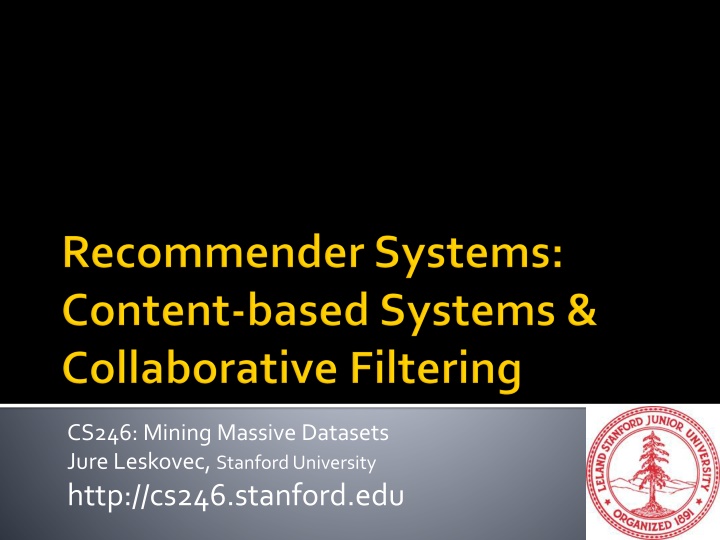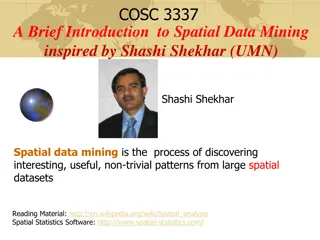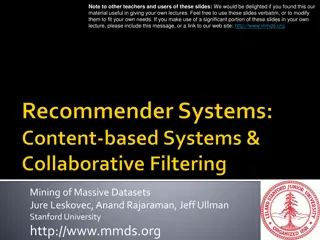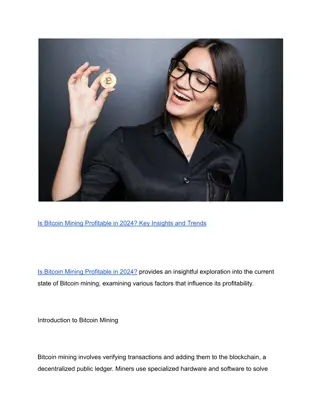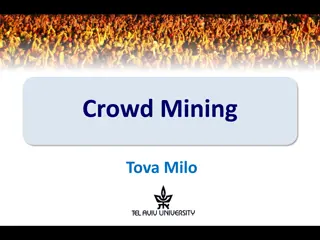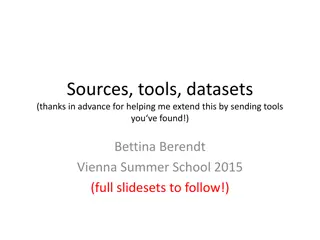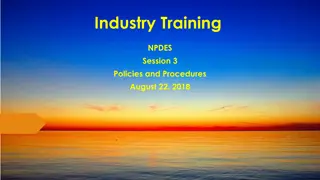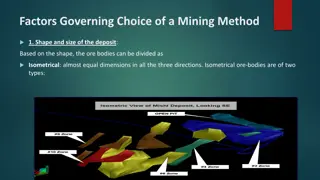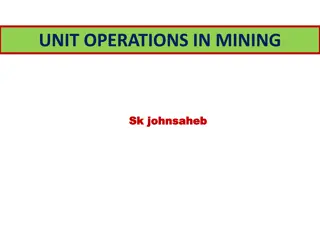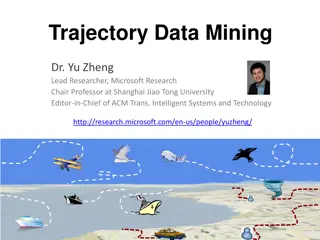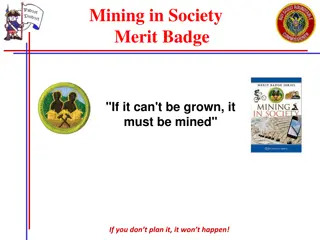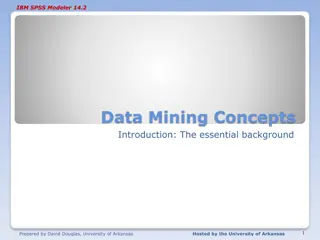Mining Massive Datasets for Better Recommendations
In this dataset mining study by Jure Leskovec at Stanford University, the focus is on the evolution of recommendation systems and the shift from scarcity to abundance in the retail landscape. The research delves into the impact of recommendation engines in shaping user choices, with examples illustrating the significance of tailored suggestions from diverse sources. The analysis covers the utility function, customer-item sets, and the implications of curated lists and personalization for platforms like Amazon and Netflix. Overall, the research highlights the transformative power of data analysis in enhancing user experiences and driving decision-making processes in the digital era.
Download Presentation

Please find below an Image/Link to download the presentation.
The content on the website is provided AS IS for your information and personal use only. It may not be sold, licensed, or shared on other websites without obtaining consent from the author.If you encounter any issues during the download, it is possible that the publisher has removed the file from their server.
You are allowed to download the files provided on this website for personal or commercial use, subject to the condition that they are used lawfully. All files are the property of their respective owners.
The content on the website is provided AS IS for your information and personal use only. It may not be sold, licensed, or shared on other websites without obtaining consent from the author.
E N D
Presentation Transcript
CS246: Mining Massive Datasets Jure Leskovec, Stanford University http://cs246.stanford.edu
Customer Y Does search on Metalica Recommender system suggests Megadeth from data collected from customer X Customer X Buys Metalica CD Buys Megadeth CD 2/18/2025 Jure Leskovec, Stanford C246: Mining Massive Datasets 2
Examples: Search Recommendations Products, web sites, blogs, news items, Items 2/18/2025 Jure Leskovec, Stanford C246: Mining Massive Datasets 3
Shelf space is a scarce commodity for traditional retailers Also: TV networks, movie theaters, Web enables near-zero-cost dissemination of information about products From scarcity to abundance More choice necessitates better filters Recommendation engines How Into Thin Air made Touching the Void a bestseller: http://www.wired.com/wired/archive/12.10/tail.html 2/18/2025 Jure Leskovec, Stanford C246: Mining Massive Datasets 4
Source: Chris Anderson (2004) 2/18/2025 Jure Leskovec, Stanford C246: Mining Massive Datasets 5
Read http://www.wired.com/wired/archive/12.10/tail.html to learn more! 2/18/2025 Jure Leskovec, Stanford C246: Mining Massive Datasets 6
Editorial and hand curated List of favorites Lists of essential items Simple aggregates Top 10, Most Popular, Recent Uploads Tailored to individual users Amazon, Netflix, 2/18/2025 Jure Leskovec, Stanford C246: Mining Massive Datasets 7
C = set of Customers S = set of Items Utility functionu: C S R R = set of ratings R is a totally ordered set e.g., 0-5 stars, real number in [0,1] 2/18/2025 Jure Leskovec, Stanford C246: Mining Massive Datasets 8
Avatar LOTR Matrix Pirates 1 0.2 Alice 0.5 0.3 Bob 0.2 1 Carol 0.4 David 2/18/2025 Jure Leskovec, Stanford C246: Mining Massive Datasets 9
Gathering known ratings for matrix Extrapolate unknown ratings from known ratings Mainly interested in high unknown ratings Evaluating extrapolation methods 2/18/2025 Jure Leskovec, Stanford C246: Mining Massive Datasets 10
Explicit Ask people to rate items Doesn t work well in practice people can t be bothered Implicit Learn ratings from user actions E.g., purchase implies high rating What about low ratings? 2/18/2025 Jure Leskovec, Stanford C246: Mining Massive Datasets 11
Key problem: matrix U is sparse Most people have not rated most items Cold start: New items have no ratings New users have no history Three approaches to Recommender Systems: Content-based Collaborative Hybrid 2/18/2025 Jure Leskovec, Stanford C246: Mining Massive Datasets 12
Main idea: Recommend items to customer x similar to previous items rated highly by x Example: Movie recommendations Recommend movies with same actor(s), director, genre, Websites, blogs, news Recommend other sites with similar content 2/18/2025 Jure Leskovec, Stanford C246: Mining Massive Datasets 13
Item profiles likes build recommend Red Circles Triangles match User profile 2/18/2025 Jure Leskovec, Stanford C246: Mining Massive Datasets 14
For each item, create an item profile Profile is a set (vector) of features Movies: author, title, actor, director, Text: set of important words in document How to pick important features? Usual heuristic from text mining is TF-IDF (Term frequency * Inverse Doc Frequency) Term feature Document item 2/18/2025 Jure Leskovec, Stanford C246: Mining Massive Datasets 15
fij = frequency of term (feature) i in document (item) j Note: we normalize TF to discount for longer documents ni = number of docs that mention term i N = total number of docs TF-IDF score:wij = TFij IDFi Doc profile = set of words with highest TF-IDF scores, together with their scores 2/18/2025 Jure Leskovec, Stanford C246: Mining Massive Datasets 16
User profile possibilities: Weighted average of rated item profiles Variation: weight by difference from average rating for item Prediction heuristic: Given user profile u and item profile i, estimate u(u,i) = cos(u,i) = u i/(|u||i|) Need efficient method to find items with high utility: LSH! 2/18/2025 Jure Leskovec, Stanford C246: Mining Massive Datasets 17
+: No need for data on other users No cold-start or sparsity problems +: Able to recommend to users with unique tastes +: Able to recommend new and unpopular items No first-rater problem Can provide explanations of recommended items by listing content-features that caused an item to be recommended 2/18/2025 Jure Leskovec, Stanford C246: Mining Massive Datasets 18
: Finding the appropriate features is hard E.g., images, movies, music : Overspecialization Never recommends items outside user s content profile People might have multiple interests Unable to exploit quality judgments of other users : Recommendations for new users How to build a user profile? 2/18/2025 Jure Leskovec, Stanford C246: Mining Massive Datasets 19
Consider user x Find set N of other users whose ratings are similar to x s ratings x N Estimate x s ratings based on ratings of users in N 2/18/2025 Jure Leskovec, Stanford C246: Mining Massive Datasets 21
Let rx be the vector of user xs ratings Jaccard similarity measure Problem: Ignores the value of the rating Cosine similarity measure sim(x,y) = cos(rx, ry) Problem: Treats missing ratings as negative Pearson correlation coefficient Sxy = items rated by both users x and y 2/18/2025 Jure Leskovec, Stanford C246: Mining Massive Datasets 22
Intuitively we want: sim(A, B) > sim(A, C) Jaccard similarity: 1/5 < 2/4 Cosine similarity: 0.386 > 0.322 Considers missing ratings as negative Solution: subtract the mean sim A,B vs. A,C: 0.092 > -0.559 Notice cos sim is correlation when data is centered at 0 2/18/2025 Jure Leskovec, Stanford C246: Mining Massive Datasets 23
Let rx be the vector of user xs ratings Let N be the set of k users most similar to x who have rated item i Possibilities for prediction for item s of user x: rxi = 1/k y N ryi rxi = ( y Nsim(x,y) ryi) / ( y Nsim(x,y)) Other options? Many tricks possible 2/18/2025 Jure Leskovec, Stanford C246: Mining Massive Datasets 24
Skip! Breaks the flow of the lecture. Expensive step is finding k most similar customers O(|C|) Too expensive to do at runtime Could pre-compute Na ve precomputation takes time O(N |C|) Can use clustering, partitioning as alternatives, but quality degrades 2/18/2025 Jure Leskovec, Stanford C246: Mining Massive Datasets 25
So far:User-user collaborative filtering Another view: Item-item For item i, find other similar items Estimate rating for item based on ratings for similar items Can use same similarity metrics and prediction functions as in user-user model = ij s s r ij uj ( ; ) j N i u r ui sij similarity of items i and j ruj rating of user u on item j N(i;u) set items rated by u similar to i j ( ; ) N i u 2/18/2025 Jure Leskovec, Stanford C246: Mining Massive Datasets 26
users 1 2 3 4 5 6 7 8 9 10 11 12 1 1 3 5 5 4 2 5 4 2 1 3 4 movies 3 2 4 1 2 3 4 3 5 4 2 4 5 4 2 5 4 3 4 2 2 5 6 1 3 3 2 4 - unknown rating - rating between 1 to 5 2/18/2025 Jure Leskovec, Stanford C246: Mining Massive Datasets 27
users 1 2 3 4 5 6 7 8 9 10 11 12 1 1 3 5 5 4 ? 2 5 4 2 1 3 4 movies 3 2 4 1 2 3 4 3 5 4 2 4 5 4 2 5 4 3 4 2 2 5 6 1 3 3 2 4 - estimate rating of movie 1 by user 5 2/18/2025 Jure Leskovec, Stanford C246: Mining Massive Datasets 28
users 1 2 3 4 5 6 7 8 9 10 11 12 1 1 3 5 5 4 ? 2 5 4 2 1 3 4 movies 2 4 1 2 3 4 3 5 3 4 2 4 5 4 2 5 4 3 4 2 2 5 1 3 3 2 4 6 Neighbor selection: Identify movies similar to movie 1, rated by user 5 2/18/2025 Jure Leskovec, Stanford C246: Mining Massive Datasets 29
users 1 2 3 4 5 6 7 8 9 10 11 12 1 1 3 5 5 4 ? 2 5 4 2 1 3 4 movies 2 4 1 2 3 4 3 5 3 4 2 4 5 4 2 5 4 3 4 2 2 5 1 3 3 2 4 6 Compute similarity weights: s13=0.2, s16=0.3 2/18/2025 Jure Leskovec, Stanford C246: Mining Massive Datasets 30
users 1 2 3 4 5 6 7 8 9 10 11 12 1 1 3 5 5 4 2.6 2 5 4 2 1 3 4 movies 2 4 1 2 3 4 3 5 3 4 2 4 5 4 2 5 4 3 4 2 2 5 1 3 3 2 4 6 ???= ?????? Predict by taking weighted average: r15=(0.2*2+0.3*3)/(0.2+0.3)=2.6 ??? 2/18/2025 Jure Leskovec, Stanford C246: Mining Massive Datasets 31
Before: s r ij s uj j ( ; ) N i u = r ui ij j ( ; ) N i u Define similarity sij of items i and j Select k nearest neighbors N(i; u) items most similar to i, that were rated by u Estimate rating rui as the weighted average: + ( ) s r b ij uj s uj j N i u ( ; ) = r b ui ui ij j N i u ( ; ) baseline estimate for rui = overall mean movie rating bu = rating deviation of user u = avg. rating of user u bi = rating deviation of movie i 2/18/2025 Jure Leskovec, Stanford C246: Mining Massive Datasets 32
Avatar LOTR Matrix Pirates 1 0.8 Alice 0.5 0.3 Bob 0.9 1 8 . 0 Carol 1 0.4 David In practice, it has been observed that item-item often works better than user-user Why? Items are simpler, users have multiple tastes 2/18/2025 Jure Leskovec, Stanford C246: Mining Massive Datasets 33
Works for any kind of item No feature selection needed Cold Start: Need enough users in the system to find a match Sparsity: The user/ratings matrix is sparse. Hard to find users that have rated the same items First rater: Cannot recommend an item that has not been previously rated New items, Esoteric items Popularity bias: Cannot recommend items to someone with unique taste Tends to recommend popular items 2/18/2025 Jure Leskovec, Stanford C246: Mining Massive Datasets 34
Implement two or more different recommenders and combine predictions Perhaps using a linear model Add content-based methods to collaborative filtering Item profiles for new item problem Demographics to deal with new user problem 2/18/2025 Jure Leskovec, Stanford C246: Mining Massive Datasets 35
movies 1 3 4 3 5 5 4 5 5 3 users 3 2 2 2 5 2 1 1 3 3 1 2/18/2025 Jure Leskovec, Stanford C246: Mining Massive Datasets 36
movies 1 3 4 3 5 5 4 5 5 3 users 3 2 ? ? Test Data Set ? 2 1 ? 3 ? 1 2/18/2025 Jure Leskovec, Stanford C246: Mining Massive Datasets 37
This discussion has been somewhat useless. Could explain it better check the book chapter! Compare predictions with known ratings Root-mean-square error (RMSE) Precision at top 10: % of those in top10 Rating of top 10: Average rating assigned to top 10 Rank Correlation: Spearman s correlation between system s and user s complete rankings. Another approach: 0/1 model Coverage: Number of items/users for which system can make predictions Precision: Accuracy of predictions Receiver operating characteristic (ROC) Tradeoff curve between false positives and false negatives 2/18/2025 Jure Leskovec, Stanford C246: Mining Massive Datasets 38
Narrow focus on accuracy sometimes misses the point Prediction Diversity Prediction Context Order of predictions In practice, we care only to predict high ratings: RMSE might penalize a method that does well for high ratings and badly for others 2/18/2025 Jure Leskovec, Stanford C246: Mining Massive Datasets 39
Skip! Leverage all the Netflix data Don t try to reduce data size in an effort to make fancy algorithms work Simple methods on large data do best Add more data e.g., add IMDB data on genres More data beats better algorithms http://anand.typepad.com/datawocky/2008/03/more-data-usual.html 2/18/2025 Jure Leskovec, Stanford C246: Mining Massive Datasets 41
Skip! Common problem that comes up in many settings Given a large number N of vectors in some high-dimensional space (M dimensions), find pairs of vectors that have high similarity e.g., user profiles, item profiles We already know how to do this! Near-neighbor search in high dimensions (LSH) Dimensionality reduction 2/18/2025 Jure Leskovec, Stanford C246: Mining Massive Datasets 42
Training data 100 million ratings, 480,000 users, 17,770 movies 6 years of data: 2000-2005 Test data Last few ratings of each user (2.8 million) Evaluation criterion: root mean squared error (RMSE) Netflix Cinematch RMSE: 0.9514 Competition 2700+ teams $1 million prize for 10% improvement on Cinematch 2/18/2025 Jure Leskovec, Stanford C246: Mining Massive Datasets 43
Next topic: Recommendations via Latent Factor models Overview of Coffee Varieties I2 C6 I1 L5 Exotic C1 S5 S2S1 S7 S6 C7 Exoticness / Price R4 R3 C4 C3 S3 R6 R2 C2 Flavored B2 a1 L4 FR S4 TE F3F2F1 F0 B1 F9 F8 F6 R5 F5 R8 F4 Popular Roasts and Blends Complexity of Flavor The bubbles above represent products sized by sales volume. Products close to each other are recommended to each other. 2/18/2025 Jure Leskovec, Stanford C246: Mining Massive Datasets 44
[Bellkor Team] serious Amadeus Braveheart The Color Purple Lethal Weapon Sense and Sensibility Ocean s 11 Geared towards males Geared towards females Dave The Lion King Dumb and Dumber The Princess Diaries Independence Day Gus escapist 2/18/2025 Jure Leskovec, Stanford C246: Mining Massive Datasets 45
Koren, Bell, Volinksy, IEEE Computer, 2009 2/18/2025 Jure Leskovec, Stanford C246: Mining Massive Datasets 46
